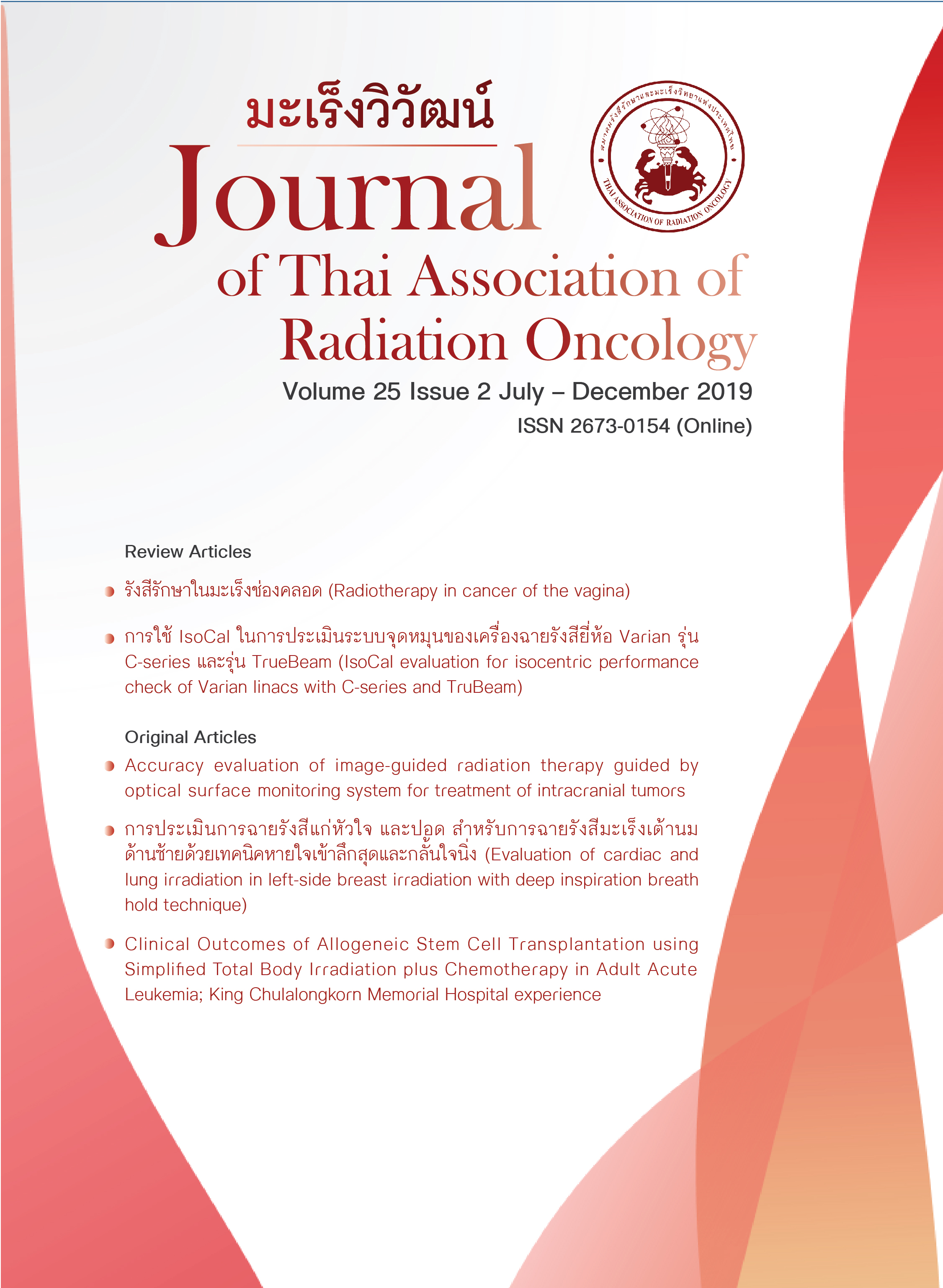Evaluation of cardiac and lung irradiation in left-side breast irradiation with deep inspiration breath hold technique
Keywords:
maximum heart distance (MHD), central lung distance (CLD), deep inspiration breath hold (DIBH), breast cancerAbstract
Background: Breathing is the major cause of uncertainty in heart and lung dose for left breast irradiation.
Objective: The aim of this study is to evaluate cardiac and lung irradiation in left sided breast cancer patients who received radiation with deep inspiration breath-hold technique and free breath technique by measuring the maximum heart distance (MHD) and the central lung distance (CLD).
Materials and Methods: The 23 patients with left sided breast irradiation were included in this study. There were two groups, free breath for 8 patients and deep inspiration breath-hold (DIBH) for 15 patients. Two opposing fields of the tangent beam were planned. Two radiation technologists measured the MHD and CLD from digitally reconstructed radiograph (DRR) and electronic portal imaging device (EPID) about 5-7 times along the course of treatment.
Results: Two independent MHD and CLD measurements were not significantly different (p-value < 0.05). The MHD and CLD for the DIBH and the free breath technique were not significantly difference. There are no different of MHD and CLD between the simulation and the course of treatment.
Conclusion: No significant difference of MHD and CLD was found between DIBH versus free breath technique and between the simulation versus the course of treatment.
References
Laoitthi P, Parinyanitikul N. Breast cancer: Epidemiology, prevention and screening recommendations. Chula Med J. 2016;60:497-507.
พันทิวา อุณห์ศิริ. การฉายรังสีระหว่างผ่าตัดด้วยเครื่อง INTRABEAM สำหรับผู้ป่วยมะเร็งเต้านม. J Thai Assoc Radiat Oncol. 2016;22:34-8.
Algara M, Arenas M, Bayo DDlPE, Muñoz J, Carceller JA, Salinas J, et al. Radiation techniques used in patients with breast cancer: results of a survey in Spain. Rep Pract Oncol Radiother. 2012;17:122-8.
Kestin LL, Sharpe MB, Frazier RC, Vicini FA, Yan D, Matter RC, et al. Intensity modulation to improve dose uniformity with tangential breast radiotherapy: initial clinical experience. Int J Radiat Oncol Biol Phys. 2000;48:1559-68.
Vicini FA, Sharpe M, Kestin L, Martinez A, Mitchell CK, Wallace MF, et al. Optimizing breast cancer treatment efficacy with intensity-modulated radiotherapy. Int J Radiat Oncol Biol Phys. 2002;54:1336-44.
Oonsiri P, Saksornchai K, Suriyapee S. Plan evaluation of intensity modulated radiation therapy and volumetric modulated arc therapy in bilateral breast irradiation with 3-isocenter technique. J Assoc Med Sci. 2018;51:81-4.
Latty D, Stuart KE, Wang W, Ahern V. Review of deep inspiration breath‐hold techniques for the treatment of breast cancer. J Med Radiat Sci. 2015;62:74-81.
Smyth LM, Knight KA, Aarons YK, Wasiak J. The cardiac dose‐sparing benefits of deep inspiration breath‐hold in left breast irradiation: a systematic review. J Med Radiat Sci. 2015;62:66-73.
Mast ME, van Kempen-Harteveld L, Heijenbrok MW, Kalidien Y, Rozema H, Jansen WP, et al. Left-sided breast cancer radiotherapy with and without breath-hold: Does IMRT reduce the cardiac dose even further? Radiother Oncol. 2013;108:248-53.
Swanson T, Grills I, Ye H, Entwistle A, Teahan M, Letts N, et al. Six-year experience routinely utilizing moderate deep inspiration breath-hold (mDIBH) for the reduction of cardiac dose in left-sided breast irradiation for patients with early stage or locally advanced breast cancer. Am J Clin Oncol 2013;36:24.
Goody R, O’Hare J, McKenna K, Dearey L, Robinson J, Bell P, et al. Unintended cardiac irradiation during left-sided breast cancer radiotherapy. Br J Radiol. 2013;86:20120434.
Topolnjak R, Sonke J-J, Nijkamp J, Rasch C, Minkema D, Remeijer P, et al. Breast patient setup error assessment: comparison of electronic portal image devices and cone-beam computed tomography matching results. Int J Radiat Oncol Biol Phys. 2010;78:1235-43.
van Haaren P, Claassen-Janssen F, van de Sande I, Boersma L, van der Sangen M, Hurkmans C. Heart position variability during voluntary moderate deep inspiration breath-hold radiotherapy for breast cancer determined by repeat CBCT scans. Phys Med. 2017;40:88-94.
Skyttä T, Kapanen M, Laaksomaa M, Peltola S, Haltamo M, Boman E, et al. Improving the reproducibility of voluntary deep inspiration breath hold technique during adjuvant left-sided breast cancer radiotherapy. Acta Oncol. 2016;55:970-5.
Kong F-M, Klein EE, Bradley JD, Mansur DB, Taylor ME, Perez CA, et al. The impact of central lung distance, maximal heart distance, and radiation technique on the volumetric dose of the lung and heart for intact breast radiation. Int J Radiat Oncol Biol Phys. 2002;54:963-71.
Oonsiri P, Wisetrinthong M, Chitnok M, Saksornchai K, Suriyapee S. An effective patient training for deep inspiration breath hold technique of left-sided breast on computed tomography simulation procedure at King Chulalongkorn Memorial Hospital. Radiat Oncol J. 2019;201-206.
Rong Y, Walston S, Welliver MX, Chakravarti A, Quick AM. Improving intra-fractional target position accuracy using a 3D surface surrogate for left breast irradiation using the respiratory-gated deep-inspiration breath-hold technique. PLoS One. 2014;9:e97933.
Downloads
Published
How to Cite
Issue
Section
License
บทความที่ได้รับการตีพิมพ์เป็นลิขสิทธิ์ของวารสารมะเร็งวิวัฒน์ ข้อความที่ปรากฏในบทความแต่ละเรื่องในวารสารวิชาการเล่มนี้เป็นความคิดเห็นส่วนตัวของผู้เขียนแต่ละท่านไม่เกี่ยวข้องกับ และบุคคลากรท่านอื่น ๆ ใน สมาคมฯ แต่อย่างใด ความรับผิดชอบองค์ประกอบทั้งหมดของบทความแต่ละเรื่องเป็นของผู้เขียนแต่ละท่าน หากมีความผิดพลาดใดๆ ผู้เขียนแต่ละท่านจะรับผิดชอบบทความของตนเองแต่ผู้เดียว




